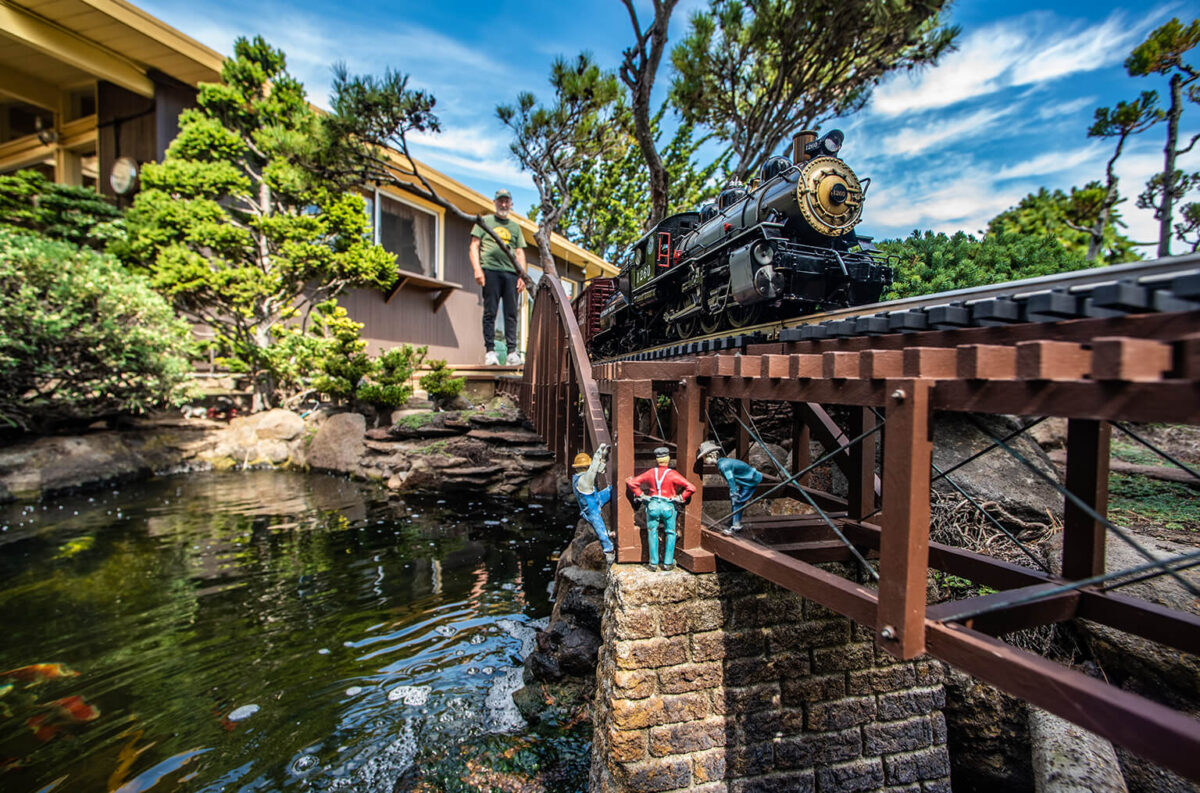Words by Johanna Harlow
Ever been out for a neighborhood stroll and pondered what lies beyond those rows of backyard fences? Maybe it’s something predictable like a hammock or a hot tub—then again, maybe it’s an entire miniature world.
Richard Murray is one of the kingdom keepers. In his Millbrae yard, the sun-tanned octogenarian strides along an extensive garden railroad bordered by Lilliputian-sized structures—a saw mill, a machine shop, a mountain lodge, a gold mine. “If you take your eye off the engine for five to ten seconds, the engine is gone,” Richard remarks, as he gestures to 550 elaborative feet of track, which weaves and wanders around clumps of bonsai trees, skirts mini-mountains and ducks in and out of tunnels. “You have to go looking for it.”
It’s quiet here today—your ear will pick up the puffing of a 2-8-0 steam engine joined by the burbling of a miniature waterfall and the occasional sucking sounds of a koi slurping bits of algae from the pond—but railroading for Richard is far from a solitary pursuit. He plays an active role in the Mid-Peninsula chapter of the Bay Area Garden Railway Society (BAGRS), the largest garden railway society in North America with several hundred members. “It’s one of the friendliest clubs I’ve ever joined,” Richard says. “Requirements are that you love trains.”
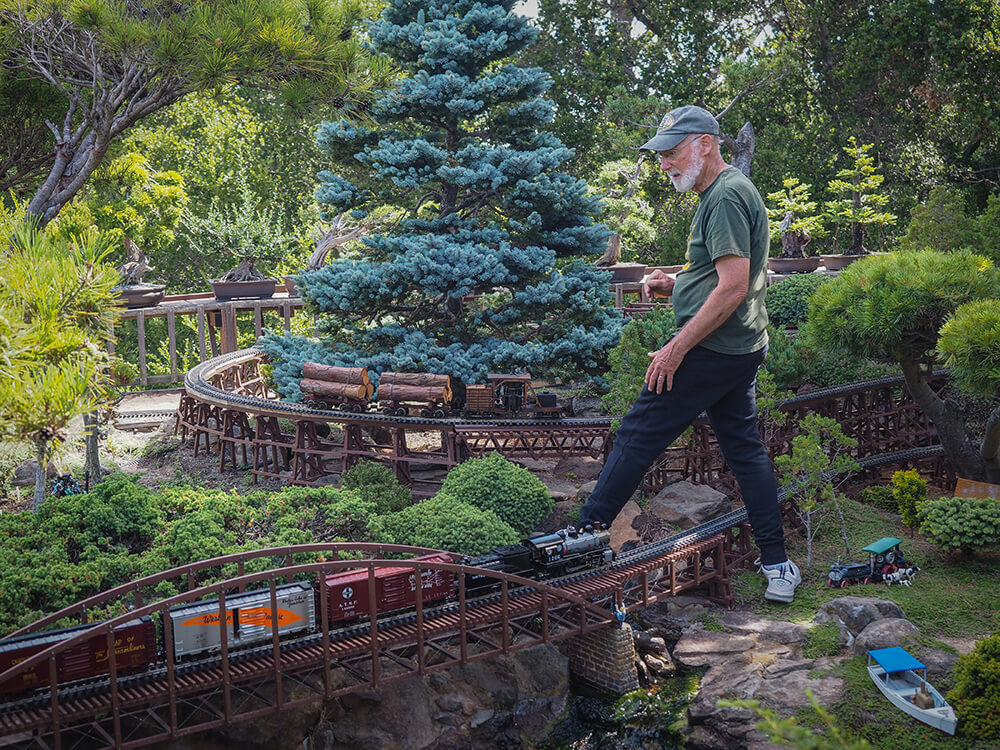
Train Club
Richard found his way to BAGRS after retiring from dentistry. “Pretty much any hobby, you should join a club,” he holds. “There is a wealth of information within any club. You don’t have to discover how the wheel works. It’s already been discovered. Just ask.”
Because of their multifaceted attributes, garden railroads can be a massive undertaking for anyone trying to build on their own. “You need to be a landscaper. You need to be a planner. You need to be a plumber. You need to be an electrician,” explains Richard.
The persistence and perspiration required for his own pièce de résistance—from the boulders stacked into proud peaks to the teeny-tiny lettering painstakingly hand-painted on the storefronts—is almost unfathomable. “It’s time-consuming. It takes hard work and imagination. Not everybody has each of those qualities,” he points out. But each member has their own expertise to lend. In fact, Richard credits his koi pond and waterfall to another’s handy skill set. “There’s probably a thousand feet of plumbing out here,” he surmises.
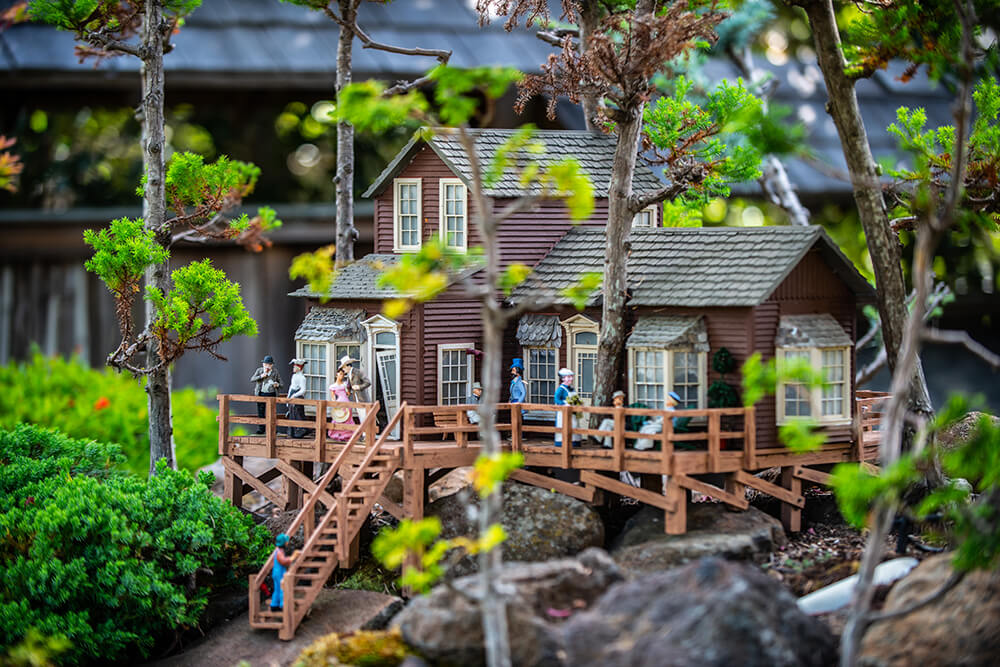
Some members specialize in electronics, while others break out lathes, drills and welders to build locomotives from scratch. Richard is a bit of a bridge guy. His most elaborate build, an almost nine-foot model of Hell’s Gate Bridge in New York City with intricate stone abutments, took him 1,000 hours of labor to complete. On the far side of the garden resides a replica of the famous cantilever bridge featured in the 1957 war film The Bridge on the River Kwai (which Richard designed after close analysis of the movie’s promo poster).
He’s also quite the garden guru. Richard’s plant-forward track shows off his membership in another organization: the Kusamura Bonsai Club. Around 300 shapely bonsai lie along the railroad’s verdant topography. “This is probably a garden that happens to have a railroad,” Richard reflects. “I think the garden still takes precedence.”
About a third of BAGRS opts for “live steam” locomotives, Richard among them. He did give electric engines a try, but… “I’d put a chair out here, watch them go around, and within a half hour I’d be sleeping,” he recalls with a chuckle. “You never get tired with steam engines. You never know what’s gonna happen next because they’re so individualistic. Two engines—the exact same model from the exact same manufacturer—might work differently… They’re all handmade. They’re gonna be different.” It could come down to a different guy on the assembly line or a dull drill, Richard says. “Some may start more easily. Some may just be ornery.”
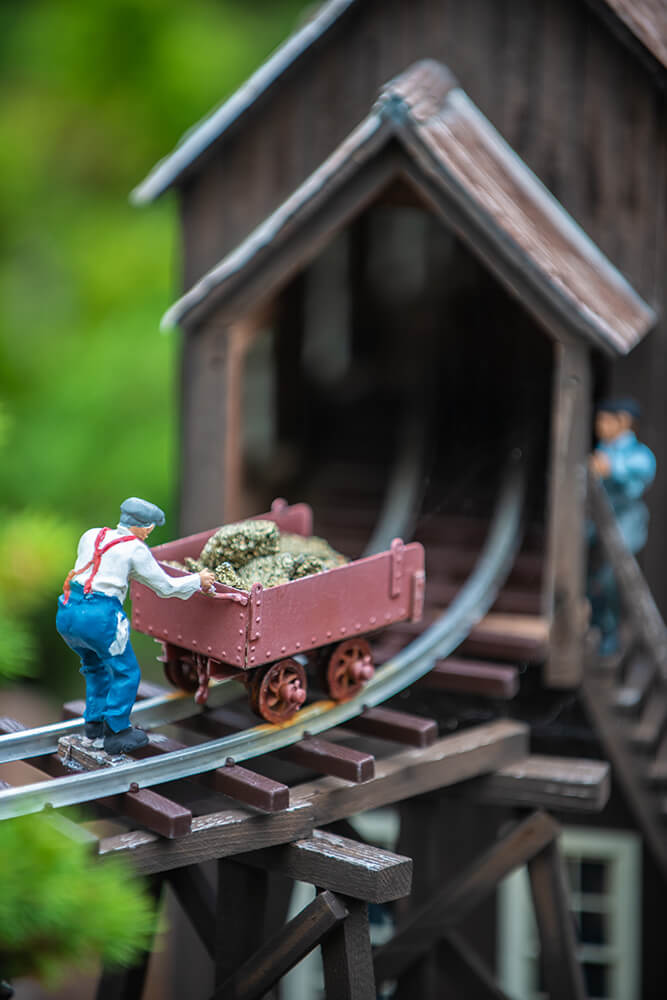
Scaled to Size
Richard steps past one of his trackside towns replete with sheriff’s office, bank, church and general store. Over his garden wall, a real-life golf course spills across the distant hills. Far-off golfers in their carts seem to-size with the plastic citizens of Richard’s realm, eliciting a sense of surrealism.
“Scale is very important,” Richard notes, bending to adjust a bowler-hatted gentleman. “When I first started, I said, ‘Whether it’s this height or this height, it’ll be fine. Yeah… It’s not. It sticks out like a sore thumb.” He now tries to keep the populace to three inches in height. No six-inch giants here.
It seems the monster-sized rats, moles and squirrels haven’t gotten the memo. “We have had lots of varmints,” laments Richard, who says the pesky rodents leave holes in the ground and dine on his plants. For BAGRS members, it’s an annoyance that comes with the territory. Far from defenseless, Richard uses an electric fence and a rat trap to keep invaders at bay.
He’s also had to fend for the koi—and blue herons, though majestic, have proven quite the foe. “I saw one of those big birds flying away, and I said, ‘I know what that bird does. I hope he didn’t stop at my yard.’ I come in and we’re one or two fish short.” Deepening the once “soup bowl-shaped’ pond has helped—especially with raccoons who dip long, agile fingers into the shallows to scoop out fishy delicacies.
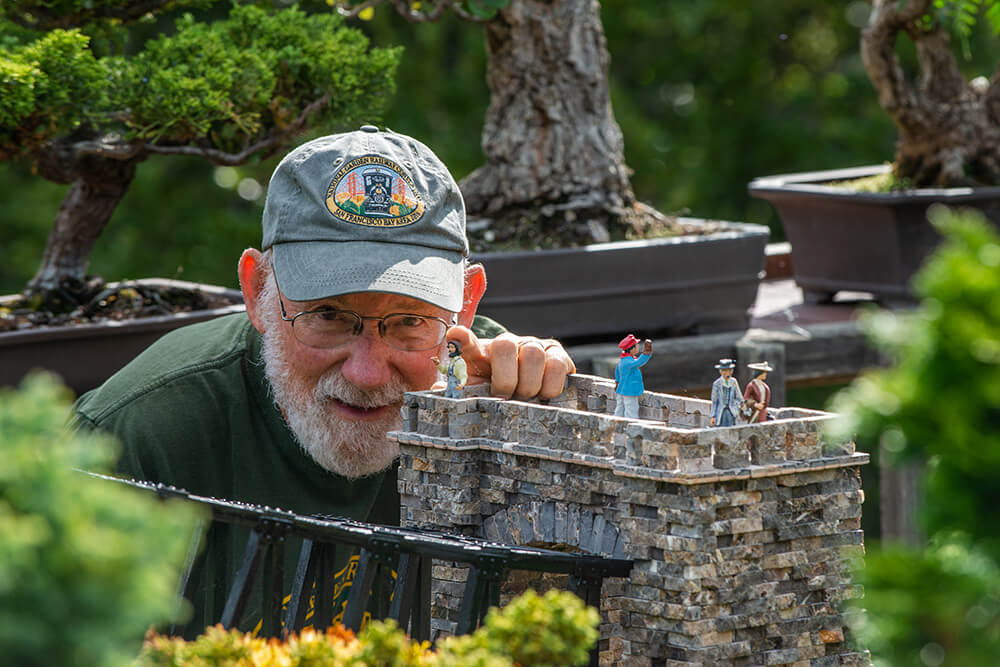
Train Talk
But what’s the point of an exhaustive labor of love if you can’t share it? Each month, when the weather is good, a handful of BAGRS members in a particular geographical region will open their railroads for a club meetup (or “steamup”). “Really, one of the reasons for the open houses is not just to show off the layouts, but for people to gather, socialize, meet with friends that perhaps you haven’t seen for a while,” Richard says. “It recharges you to be amongst friends with like minds.”
Beyond its monthly gatherings, BAGRS hosts an Annual Membership Meeting. It’s an all-day affair with breakfast and multiple members giving talks on everything from historical railroads on the West Coast to Walt Disney’s fascination with model trains.
But the Big One happens every five or so years when the club hosts the National Garden Railway Convention. This summer, nearly 1,000 attendees (some international) convened for dozens of talks, access to operating layouts and railroad supply vendors, opportunities to hop aboard the Napa Valley Wine Train and Roaring Camp Train and open invites to more than 60 backyard garden railways stretching from Sonoma to Santa Cruz. “We’re the ones oftentimes who do the national conventions because we are one of the biggest and most active railroad clubs in the United States,” Richard explains.
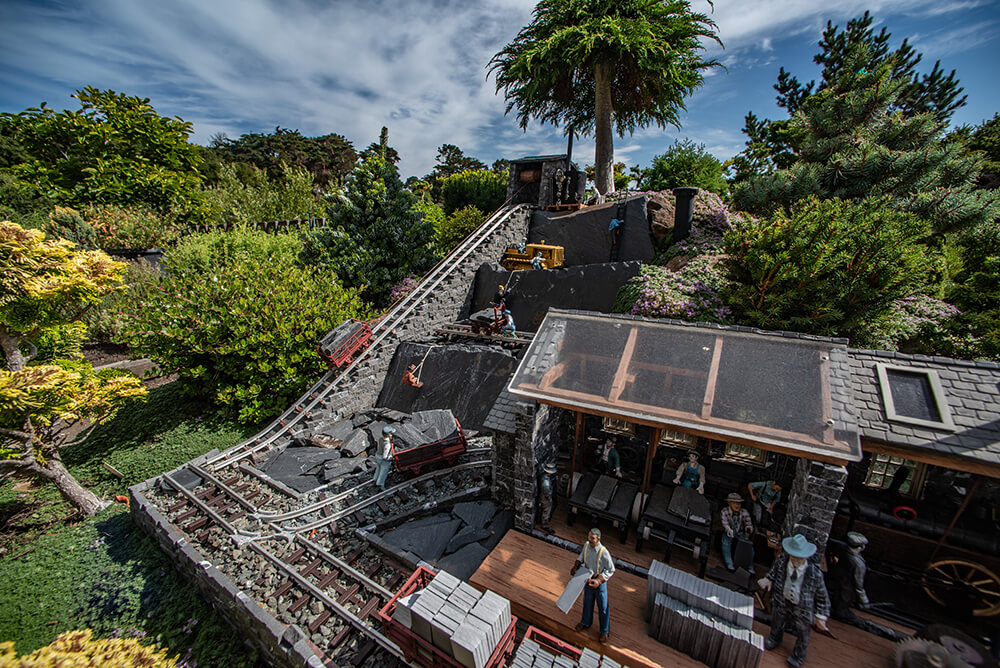
Dream in Steam
These days, Richard spends the majority of his track time pruning plants and performing a slew of groundskeeping activities. “It’s a full-time job!” he notes. Though the project is never fully finalized, he speaks wistfully of the years he toiled to actualize the layout.
“I was building it so I could run engines, play with the railroads, but frankly what I didn’t realize at the time is that it’s actually more fun to build things,” he muses. “Building the railroad required a lot of sweat, a lot of money, a lot of time. But it was thoroughly enjoyable. And I remember many of the moments—I treasure them.”
He’s clearly come a long way from the Lionel track that once ran a simple circuit around his childhood Christmas tree. But no matter the scope, time with locomotives always triggers nostalgia. “It brings out the kid in all of us,” Richard reflects, as his eyes come to rest on an itty-bitty boat, docked and waiting to launch into the pond where whale-sized koi swim.
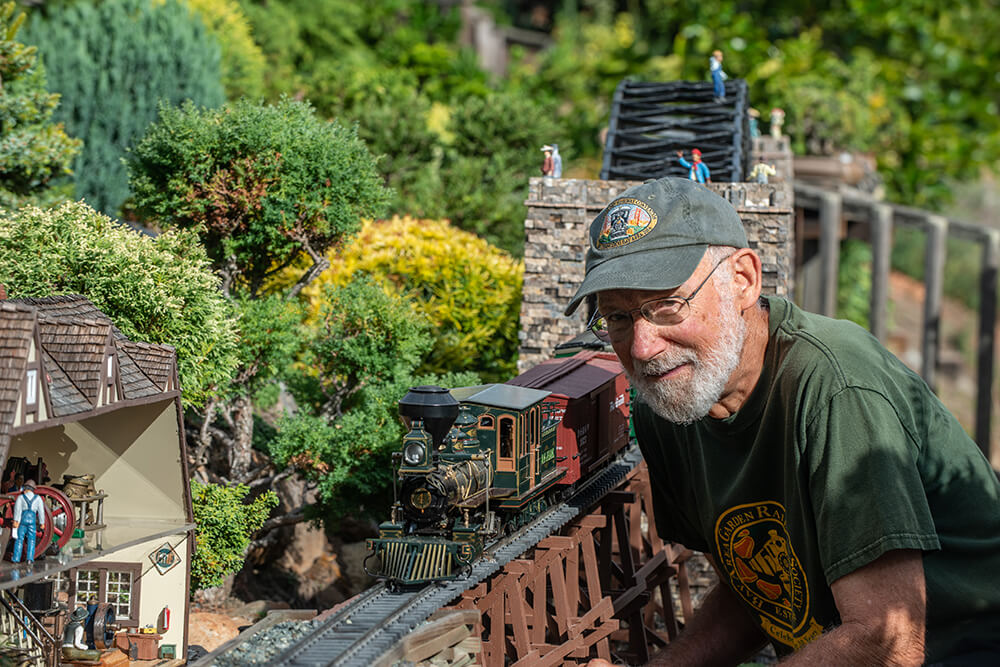
Garden Railways Take Different Routes by BAGRS President Mick Spilsbury + Era: Many garden railroads recapture the age of steam. Others operate modern diesel equipment. + Size: Some take over an entire yard with hundreds of feet of track. Others are limited to a section of a yard. + Complexity: This varies a lot. A few are built for elaborate switching operations. Some are built for simple watch-while-having-an-adult-beverage operation! + Power: Locos use power from the tracks or on-board battery power. Still others are live steamers, burning butane or coal. + Detailing: Some are highly detailed with many buildings, figures, animals and all manner of smaller trackside details. Others focus on operations. Some garden railroaders build locos from scratch, but most are purchased ready to run (though often customized in some way). + Plants: Some garden railroaders focus on plants; some don’t. Many railroads feature miniature plants, some carefully trimmed to look like scale trees. + Sounds: Most have locos with sound on board. Others feature trackside sounds including animal sounds, music or even mine operations. + Lighting: Many have elaborate lighting for night operations but not all. + Realism: Some model an actual railroad while many are the product of the owner’s imagination, with backstories to match.


